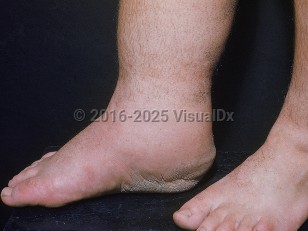Congenital lymphedema in Infant/Neonate
Alerts and Notices
Important News & Links
Synopsis

Lymphedema refers to the abnormal accumulation of protein-rich interstitial fluid secondary to lymphatic dysfunction. Primary forms of lymphedema are due to developmental abnormalities of the lymphatic system and include congenital lymphedema (Milroy disease; present at birth or soon after), lymphedema praecox (Meige disease; onset typically in teenage years), and lymphedema tarda (onset after age 30).
Congenital lymphedema is caused by a mutation in the FLT4 gene, which encodes the vascular endothelial growth factor receptor 3 (VEGFR-3), that leads to aplasia or hypoplasia of lymphatic channels. It is inherited in an autosomal dominant fashion and presents with lymphedema that develops before the age of 2. It is typically present from birth or shortly thereafter and may be either bilateral or asymmetric. At first, the dorsal feet are edematous. As the child grows, this may progressively involve the entire lower leg. The degree and distribution of the edema can vary widely from case to case, even among individuals of the same family.
Lymphedema does not usually affect longevity, and serious complications of lymphedema are rare, but lasting and/or bothersome cosmetic imperfections are experienced, as well as functional impairment. Complications include recurrent cellulitis, lymphangitis, and deep venous thrombosis. People with chronic lymphedema have a higher risk of developing lymphangiosarcoma, a highly aggressive angiosarcoma with poor prognosis.
Other associations include hydrocele and urethral abnormalities in males, such as urethral stricture or hypospadias. Prominent lower extremity veins and hemangiomas may be seen.
Atypical presentations of Milroy disease secondary to de novo VEGFR-3 mutations may include prenatal pleural effusion, spontaneous resorption of lymphedema, and elephantiasis.
The overall prevalence is unknown.
Congenital lymphedema is caused by a mutation in the FLT4 gene, which encodes the vascular endothelial growth factor receptor 3 (VEGFR-3), that leads to aplasia or hypoplasia of lymphatic channels. It is inherited in an autosomal dominant fashion and presents with lymphedema that develops before the age of 2. It is typically present from birth or shortly thereafter and may be either bilateral or asymmetric. At first, the dorsal feet are edematous. As the child grows, this may progressively involve the entire lower leg. The degree and distribution of the edema can vary widely from case to case, even among individuals of the same family.
Lymphedema does not usually affect longevity, and serious complications of lymphedema are rare, but lasting and/or bothersome cosmetic imperfections are experienced, as well as functional impairment. Complications include recurrent cellulitis, lymphangitis, and deep venous thrombosis. People with chronic lymphedema have a higher risk of developing lymphangiosarcoma, a highly aggressive angiosarcoma with poor prognosis.
Other associations include hydrocele and urethral abnormalities in males, such as urethral stricture or hypospadias. Prominent lower extremity veins and hemangiomas may be seen.
Atypical presentations of Milroy disease secondary to de novo VEGFR-3 mutations may include prenatal pleural effusion, spontaneous resorption of lymphedema, and elephantiasis.
The overall prevalence is unknown.
Codes
ICD10CM:
Q82.0 – Hereditary lymphedema
SNOMEDCT:
399889006 – Hereditary lymphedema type I
Q82.0 – Hereditary lymphedema
SNOMEDCT:
399889006 – Hereditary lymphedema type I
Look For
Subscription Required
Diagnostic Pearls
Subscription Required
Differential Diagnosis & Pitfalls

To perform a comparison, select diagnoses from the classic differential
Subscription Required
Best Tests
Subscription Required
Management Pearls
Subscription Required
Therapy
Subscription Required
References
Subscription Required
Last Reviewed:06/13/2017
Last Updated:06/19/2017
Last Updated:06/19/2017
Congenital lymphedema in Infant/Neonate

